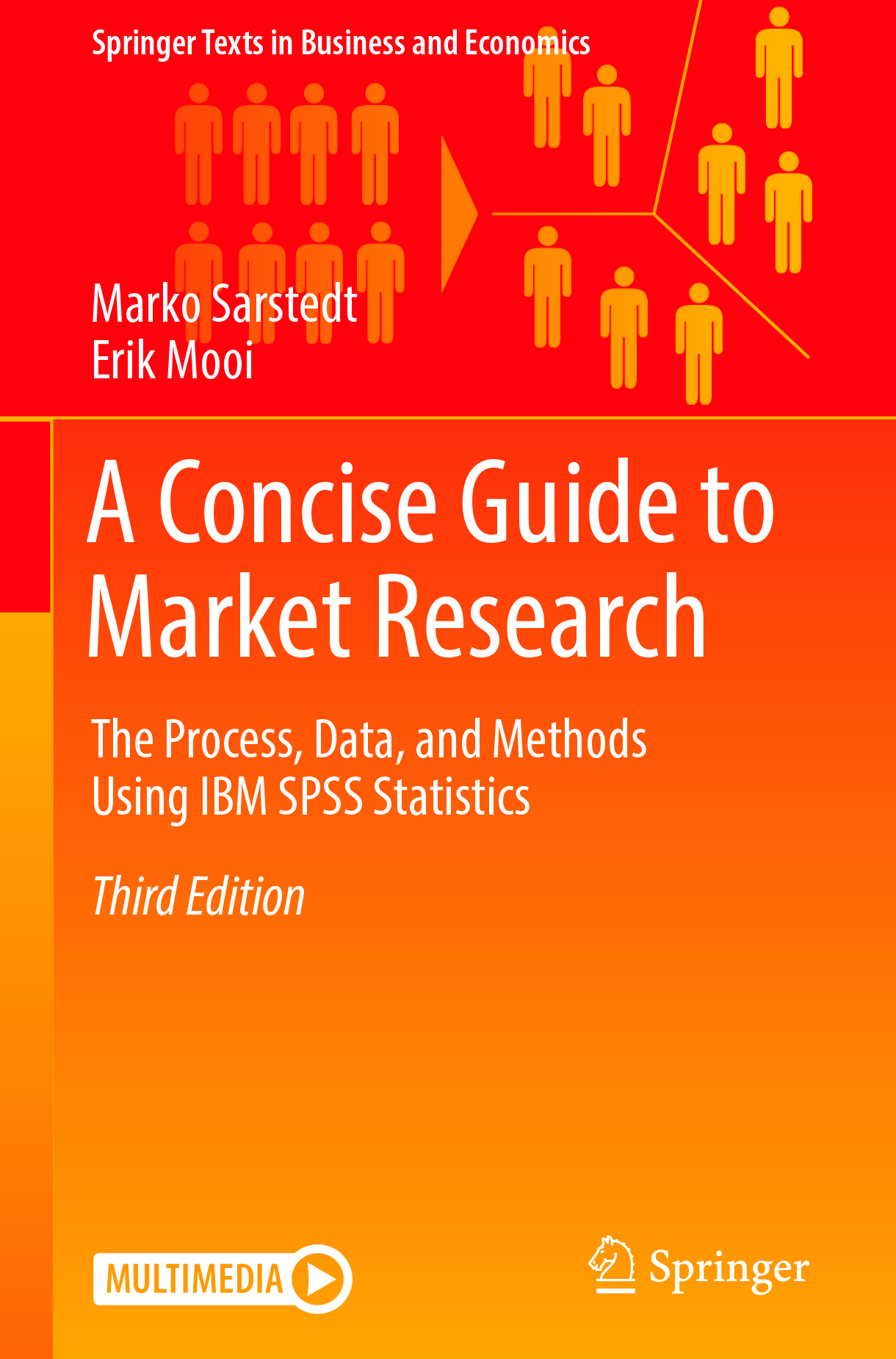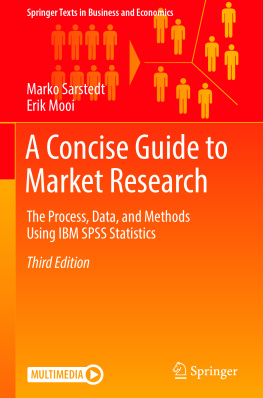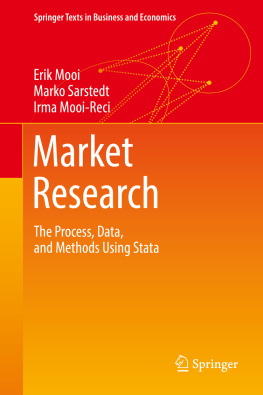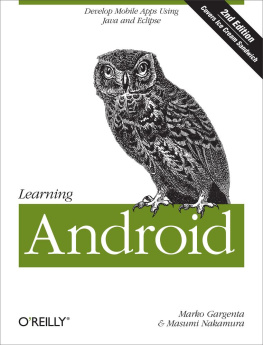Marko Sarstedt - A Concise Guide to Market Research
Here you can read online Marko Sarstedt - A Concise Guide to Market Research full text of the book (entire story) in english for free. Download pdf and epub, get meaning, cover and reviews about this ebook. year: 0, publisher: Springer Berlin Heidelberg, genre: Business. Description of the work, (preface) as well as reviews are available. Best literature library LitArk.com created for fans of good reading and offers a wide selection of genres:
Romance novel
Science fiction
Adventure
Detective
Science
History
Home and family
Prose
Art
Politics
Computer
Non-fiction
Religion
Business
Children
Humor
Choose a favorite category and find really read worthwhile books. Enjoy immersion in the world of imagination, feel the emotions of the characters or learn something new for yourself, make an fascinating discovery.
- Book:A Concise Guide to Market Research
- Author:
- Publisher:Springer Berlin Heidelberg
- Genre:
- Year:0
- Rating:5 / 5
- Favourites:Add to favourites
- Your mark:
- 100
- 1
- 2
- 3
- 4
- 5
A Concise Guide to Market Research: summary, description and annotation
We offer to read an annotation, description, summary or preface (depends on what the author of the book "A Concise Guide to Market Research" wrote himself). If you haven't found the necessary information about the book — write in the comments, we will try to find it.
A Concise Guide to Market Research — read online for free the complete book (whole text) full work
Below is the text of the book, divided by pages. System saving the place of the last page read, allows you to conveniently read the book "A Concise Guide to Market Research" online for free, without having to search again every time where you left off. Put a bookmark, and you can go to the page where you finished reading at any time.
Font size:
Interval:
Bookmark:

Springer Texts in Business and Economics (STBE) delivers high-quality instructional content for undergraduates and graduates in all areas of Business/Management Science and Economics. The series is comprised of self-contained books with a broad and comprehensive coverage that are suitable for class as well as for individual self-study. All texts are authored by established experts in their fields and offer a solid methodological background, often accompanied by problems and exercises.
More information about this series at http://www.springer.com/series/10099

Electronic supplementary material
The online version of this book contains supplementary material that is available to authorized users. You can also download the Springer Nature More Media App from the iOS or Android App Store to stream the videos and scan the image containing the Play button.
This Springer imprint is published by the registered company Springer-Verlag GmbH, DE part of Springer Nature.
The registered company address is: Heidelberger Platz 3, 14197 Berlin, Germany
To Alexandra, Charlotte, Maximilian, and Johannes
Marko Sarstedt
To Irma
Erik Mooi
In the digital economy, data have become a valuable commodity, much in the way that oil is in the rest of the economy (Wedel and Kannan 2016). Data enable market researchers to obtain valuable and novel insights. There are many new sources of data, such as web traffic, social networks, sensors that track suppliers, customers and shipments, online surveys, and others. A Forbes (2015a) survey of senior executives reveals that 96 % of the respondents consider data-driven marketing crucial to success. Not surprisingly, data are valuable to companies who spend over $44 billion a year on obtaining insights (Statista.com 2017). So valuable are these insights that companies go to great lengths to conceal the findings. Apple, for example, is known to carefully hide that it conducts a great deal of research, as the insights from this enable the company to gain a competitive advantage (Heisler 2012).
This book is about being able to supply such insights. It is a valuable skill for which there are abundant jobs. Forbes (2015b) shows that IBM, Cisco, and Oracle alone have more than 25,000 unfilled data analysis positions. Davenport and Patil (2012) label data scientists The Sexiest Job of the 21st Century .
This book is a bridge between the theory of conducting quantitative research and its execution, using the market research process as a framework. We discuss market research, starting off by identifying the research question, designing the data collection process, collecting, and describing data. We also introduce essential data analysis techniques and the basics of communicating the results, including a discussion on ethics. Each chapter on quantitative methods describes key theoretical choices and how these are executed in SPSS. Unlike most other books, we do not discuss theory or application, but link the two.
This is a book for non-technical readers! All chapters are written in an accessible and comprehensive way so that readers without a profound background in statistics can also understand the introduced data analysis methods. Each chapter on research methods includes examples to help the reader gain a hands-on feeling for the technique. Each chapter concludes with an illustrated case that demonstrates the application of a quantitative method.
To facilitate learning, we use a single case study throughout the book. This case deals with a customer survey of a fictitious company called Oddjob Airways (familiar to those who have seen the James Bond movie Goldfinger). We also provide additional end-of-chapter cases, including different datasets, thus allowing the readers to practice what they have learnt. Other pedagogical features, such as keywords, examples, and end-of-chapter questions, support the contents.
This book is concise, focusing on the most important aspects that a market researcher, or manager interpreting market research, should know.
Many chapters provide links to videos, further readings, and other websites. We also include a comprehensive Web Appendix with information on additional analysis techniques and datasets.
The book makes use of the Springer Nature More Media App ( http://www.springer.com/gp/marketing/springer-multimedia-app ), which allows you to scan an image tagged with the Play Button and stream videos directly to your mobile device. The App allows saving the documents on your device and keeps track of your 50 most recently accessed media. This unique merger of offline and online content offers readers a broad spectrum of additional and readily accessible information. You can download the Springer Nature More Media App from the Apple App Store or from Google Play.
Lastly, we have set up a Facebook page called
Font size:
Interval:
Bookmark:
Similar books «A Concise Guide to Market Research»
Look at similar books to A Concise Guide to Market Research. We have selected literature similar in name and meaning in the hope of providing readers with more options to find new, interesting, not yet read works.
Discussion, reviews of the book A Concise Guide to Market Research and just readers' own opinions. Leave your comments, write what you think about the work, its meaning or the main characters. Specify what exactly you liked and what you didn't like, and why you think so.













